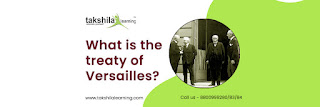What was the treaty of Versailles? History Notes for Class 9
When World War I came to a close, the Central Powers and the Allies signed the Treaty of Versailles. The Treaty of Versailles defined the terms of peace between the victorious Allies and Germany. It was signed in June 1919 at the Palace of Versailles in Paris. The Treaty of Versailles held Germany responsible for the outbreak of the war and imposed harsh penalties for territorial loss, hefty compensation payments, and militarism.
When World War I came to a conclusion on June 28, 1919, the Central Powers and the Allies signed the Treaty of Versailles. On June 28, 1919, World War I came to a conclusion, and the peace treaty was signed on January 10, 1920.
On January 18th, 1919, the Paris Peace Conference began. It commemorates the German Emperor Wilhelm I's coronation at the Palace of Versailles at the end of the Franco-Prussian War of 1871.
Click to know, signing terms of the Treaty of Versailles
Tag - treaty of Versailles facts; treaty of Versailles germany; NCERT Class 9; History

Comments
Post a Comment
Thank you we will contact ASAP.